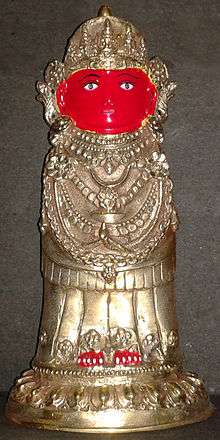Bunga Dyah Jatra (chariot festival)
| Bunga Dyah Jatra | |
|---|---|
 The chariot of Bunga Dyah | |
| Also called | Rato Machhendranath Jatra |
| Observed by | Nepalese |
| Type | Religious |
| Significance | Spreads peace in the city |
| Celebrations | Chariot procession |
| 2015 date | 23 April |
Buṅga Dyaḥ Jātrā (Newar: बुंग द्यः जात्रा) is a chariot procession honoring the Buddhist deity of compassion Avalokiteśvara held in Lalitpur, Nepal. It is one of the greatest religious events in the city and the longest chariot festival celebrated in the country.
Buṅga Dyaḥ is also known as Raktalokitesvara Karunamaya and Rāto Machhindranāth and is revered as the giver of rain.[1][2] The name Rato Machhendranath means Red Machhendranath in a reference to the color of the deity's image.[3] The chariot festival is held according to the lunar calendar, so the date is changeable. It begins on the 4th day of the bright fortnight of Bachhalā, the seventh month in the lunar Nepal Sambat calendar.
Chariot procession
The chariot procession was instituted to celebrate the arrival of Bunga Dyah in Nepal and the end of a devastating drought. It was started when Narendra Deva was the king (640-683 AD).[4]
Preparations for the festival begin with the construction of a 60-foot tall chariot at Pulchok at the western end of Lalitpur. When the chariot is complete, the image of Bunga Dyah from his temple is installed in it. Revellers then drag the chariot through the streets of Lalitpur on a tour that lasts a month. The chariot of Bunga Dyah is accompanied on the journey by a similar but smaller chariot of Chākuwā Dyah (चाकुवा द्यः). The deity is another Bodhisattva and is also known as Minnāth.
The route of the chariot procession starts at Pulchok and passes through Gabahal, Hakha, Sundhara, Lagankhel and ends at Jawalakhel. As per time-honored tradition, the chariot is pulled exclusively by women on the stretch between the localities of Iti and Thati. This part of the chariot procession is known as Yākah Misāyā Bhujyā (याकः मिसाया भुज्या).[5]
The parade finishes at the open ground of Jawalakhel which is situated at the western side of Lalitpur. There, the festivities conclude with the ceremony of Bhoto Jatra, the display of the bhoto, a traditional Nepalese vest.[6]
Bhoto Jātrā

Bhoto Jatra, which literally means "vest festival", is the climax of the chariot procession of Bunga Dyah Jatra. After the two chariots arrive in Jawalakhel, astrologers choose an auspicious date to hold the Bhoto Jatra festival. On the appointed day in the presence of the head of state, a government official climbs on to the chariot and holds up a jewel-studded black vest from the four sides of the chariot so that all the people gathered around can have a look at it.
The display is a re-enactment of an event that happened eons ago. According to legend, a Jyapu (Newar farmer) lost the vest which he had received as a gift from the serpent god Karkotaka Naga for doing him a favour. One day, the farmer had come to Jawalakhel to watch the chariot pulling festival where he saw someone wearing his missing garment.
A quarrel developed over the vest, and since neither party could prove ownership, it was agreed that the undershirt would be kept with Bunga Dyah until the rightful owner comes to claim it with adequate proof. Since then, the vest has been shown to the public annually as a call to potential claimants to step forward.
The living goddess Kumari of Patan also arrives in Jawalakhel to observe Bhoto Jatra. She watches the ceremony from a special rest house.[7] The auspicious day when the Bhoto Jatra is held is determined by astrologers, so the date is changeable.[8] In 2014, the vest showing will be held on 22 June.[9]
After the festival, the chariot is dismantled and the parts are stored until it is time for the procession the next year. Rato Machhendranath is taken to a temple in the nearby village of Bungamati, also known as the second home of the rain god. The deity spends the next six months in that temple.[10]
Gallery
-
 Rato Machhendranath (Bunga Dyah)
Rato Machhendranath (Bunga Dyah) -
 Miniature statue of Bunga Dyah
Miniature statue of Bunga Dyah -
 The chariot of Minnath (Chakuwa Dyah)
The chariot of Minnath (Chakuwa Dyah) -
 Chakuwa Dyah and Bunga Dyah ca 1920s
Chakuwa Dyah and Bunga Dyah ca 1920s -
 Chariot of Chakuwa Dyah ca 1930s
Chariot of Chakuwa Dyah ca 1930s -
 Chariot of Bunga Dyah ca 1930s
Chariot of Bunga Dyah ca 1930s
References
- ↑ Locke, John Kerr (1973). Rato Masyendranath of Patan and Bungamati. Institute of Nepal and Asian Studies. p. 81. Retrieved 11 April 2014.
- ↑ Vajracharya, Munindraratna (1998). "Karunamaya Jatra in Newar Buddhist Culture". Aioiyama. Retrieved 11 April 2014.
- ↑ Shrestha, Binu. "Pulling Chariot To Invoke Monsoon God". The Rising Nepal. Kathmandu. Retrieved 15 April 2014.
- ↑ Wright, Daniel (1877). History of Nepal. Asian Educational Services. pp. 147–149. Retrieved 27 April 2014.
- ↑ "Misa Shakti". Sandhya Times. Kathmandu. 12 May 2014. p. 1.
- ↑ Locke, John Kerr (1973). Rato Masyendranath of Patan and Bungamati. Institute of Nepal and Asian Studies. p. 17. Retrieved 11 April 2014.
- ↑ Locke, John Kerr (1980). Karunamaya: The Cult of Avalokitesvara-Matsyendranath in the Valley of Nepal. Kathmandu: Sahayogi Prakashan for Research Centre for Nepal and Asian Studies, Tribhuvan University. p. 273. Retrieved 14 April 2014.
- ↑ "Bhoto Jatra marked amid much fanfare". The Kathmandu Post. 28 June 2011. Retrieved 11 April 2014.
- ↑ "Lord Machchhindranath Voto (vest) exhibiton to be held on June 22". The Rising Nepal. Kathmandu. 23 May 2014. p. 6. Retrieved 24 May 2014.
- ↑ Locke, John Kerr (1973). Rato Masyendranath of Patan and Bungamati. Institute of Nepal and Asian Studies. p. 17. Retrieved 11 April 2014.